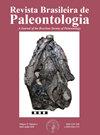Mixed marine, brackish water, non-marine, and subaerial microfaunal association in the Red Marls Formation of the Western Aurès Basin (Upper Paleocene)
IF 0.6
4区 地球科学
Q4 PALEONTOLOGY
引用次数: 0
Abstract
In the western part of the Aurès Basin (northeastern Algeria), the Red Marls of El Kantara Formation records a mixed microfaunal association of non-marine-brackish ostracoda, marine foraminifera, lacustrine charophytes, and subaerial Microcodiums. Based on the recovered biotic component, it is considered that the Red Marls of El-Kantara Formation date from the upper Paleocene (Thanetian). Seven species of brackish water (Neocyprideis raoi) and non-marine ostracoda (Frambocythere tumiensis anjarensis, Paracypretta jonesi, Paracypretta verruculosa, Limnocythere deccanensis, Darwinula torpedo and Zonocypris spirula), have been discovered for the first time in Algeria and on the south Tethyan margin. Paleoenvironmentally, the overall biotic assemblage recovered indicates the presence of a freshwater palustrine/lacustrine depositional system connected to a low energy stream/river. This indicates that marginal marine conditions were prevalent in northeastern Algeria’s far inland regions. Paleobiogeographically, the seven known ostracod species have limited distributions that are until now common only with India. However, this disproved the theory that these species are endemic to the Indian Subcontinent, which is confirmed by their association with cosmopolitan charophytes. Keywords: limnic ostracoda, charophytes, paleobiogeography, Thanetian, western Aurès, Algeria.西奥伦斯盆地红沼泽组(古新世上古新世)海相、半咸水、非海相和陆相混合微动物组合
在aur盆地西部(阿尔及利亚东北部),El Kantara组红沼泽记录了一个由非海洋半咸淡水介形虫、海洋有孔虫、湖相轮虫和陆生微孔虫组成的混合微动物群。根据已恢复的生物成分,认为El-Kantara组红泥滩形成于上古新世(Thanetian)。在阿尔及利亚和南特提斯边缘首次发现了7种半咸水类(Neocyprideis raoi)和非海洋介形类(Frambocythere tumiensis anjarensis、Paracypretta jonesi、Paracypretta verruculosa、Limnocythere deccanensis、Darwinula torpedo和Zonocypris spirula)。古环境方面,恢复的整体生物组合表明存在与低能量流/河流相连的淡水湖/湖沉积体系。这表明阿尔及利亚东北部的内陆地区普遍存在边缘海洋条件。在古生物地理学上,已知的7种介形类动物分布有限,直到现在只在印度常见。然而,这证明了这些物种是印度次大陆特有的理论是错误的,这一理论被它们与世界各地的蕨类植物的联系所证实。关键词:湖滨介形类,叶门类,古生物地理,塔尼提亚,西阿尔及利亚
本文章由计算机程序翻译,如有差异,请以英文原文为准。
求助全文
约1分钟内获得全文
求助全文
来源期刊

Revista Brasileira De Paleontologia
PALEONTOLOGY-
CiteScore
1.60
自引率
14.30%
发文量
25
审稿时长
>12 weeks
期刊介绍:
It publishes original contributions on all aspects of Paleontology. Papers are written in English, Spanish, or Portuguese and are reviewed by international experts.
 求助内容:
求助内容: 应助结果提醒方式:
应助结果提醒方式:


